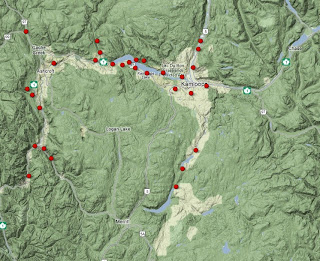How much wood would a woodpecker peck….
BC Ministry of Environment. 2013. Plants & animals search results [Red & blue list] - BC Species and Ecosystems Explorer. BC Ministry of Environment, BC. Available from http://a100.gov.bc.ca/pub/eswp/search.do?method=process&searchType=COMBINED&bcList=Red&bcList=Blue(accessed January 22, 2013)
Columbia River Basin Biodiversity Atlas. 2010. Lewis’s Woodpecker search. http://www.biodiversityatlas.org/index.html. (accessed January 23, 2013)
Wild Birds Unlimited. 2010. Educational Resources on Woodpeckers. Available from: http://www.wbu.com/education/woodpeckers.html . (Accessed January 23, 2013)
 |
| Photo source: http://www.birdweb.org/birdweb/bigger_image.aspx?id=4556&type=p |
For the Lewis Woodpecker, he probably wouldn’t peck any if he could help it.
The Lewis Woodpecker (Melanerpes
lewis) is a very interesting species as they don’t have a strong beak and
thus prefer not to make their own burrows, or they will burrow in trees which are
dead or burnt (Columbia River Basin Biodiversity Atlas, 2010). These birds are
also known to commandeer old tree burrows of other species (BC Ministry of
Environment, 2013). This is a
woodpecker species which is red-listed in BC and on the COSEWIC list they are
considered threatened (BC Ministry of Environment, 2013). They commonly live in
western Canada and United States, but are not as easily found in Canada as much
of their habitat has been lost to development. Habitat loss has hit them
strongly as they have lifelong pairing and strong site fidelity, meaning that
they often return to the same breeding and wintering grounds year after year (BC
Ministry of Environment, 2013).
Since there have been sighting of these birds around the
Kamloops area (see map below), and Kamloops appears to be a perfect habitat for them, I think
it would be a great idea to determine if they do indeed live in this area.
Specifically, I would like to look at Kenna Cartwright Park, which contains
many dead trees perfect for burrows, and to determine if there is a population
living there and how they are doing. Some web sources have said they some
woodpeckers are known to live in bird boxes, but I’m wondering if there would
be a way to create artificial burrows in some of the dead trees in Kenna. Lac
Du Bois area would also be a potential site to investigate, as it contains many
of the habitat characteristics favoured by this species. So, if you are out an
about in those areas, keep your eyes and ears open for these very cute creatures! I
have also attached a link so that you may listen to the sounds they make, as
they do not sing.
Sound
source: http://www.birdweb.org/birdweb/bird/lewiss_woodpecker
Fun Facts about Woodpeckers:
- To deal with the constant pounding of their beaks against wood they have air bubbles in their heads to absorb the shock (Wild Birds Unlimited, 2012)
- The Lewis Woodpecker does not peck the wood to catch prey, they catch prey while flying or on the ground.
- There are more than 180 species of woodpeckers.
Word Count: 400


I really like the idea of going out and looking for these birds. Nice work!
ReplyDeleteSounds like a fun project
ReplyDeleteThey are quite pretty birds!! Almost looks like a humming bird...
ReplyDeleteThis could be a fun project to do. I'm assuming they migrate away from Kamloops in the winter time though? So if we did do this as a project, perhaps we could focus on building the artificial burrows before they migrate back. I really love the idea though!
ReplyDeleteI like your creative spin on bird boxes, ie building the burrows into the dead trees. if it increases the likelihood of the woodpeckers using it over the external boxes then it would be more than worth it to go to the trouble to figure out how to do it. nice post!
ReplyDeleteI like it! It'd be fun to take a trip through Kenna and see if we can find/hear them.
ReplyDeleteI like that this is local and manageable. I go hiking in Kenna from time to time, so I'll be sure to be on the look out/listen out (?) when I'm up there next!
ReplyDelete